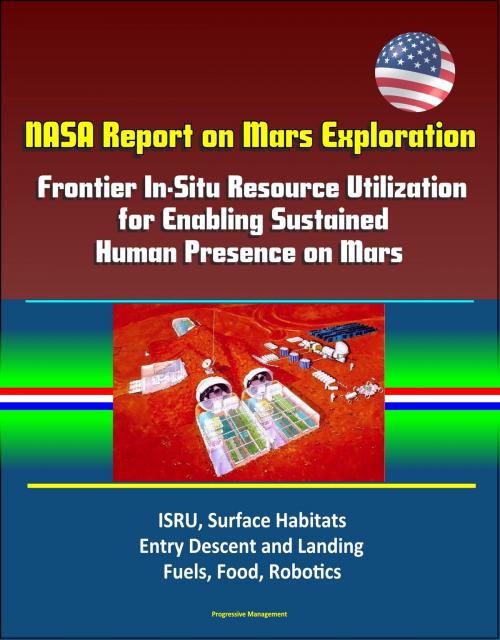NASA Report on Mars Exploration: Frontier In-Situ Resource Utilization for Enabling Sustained Human Presence on Mars - ISRU, Surface Habitats, Entry Descent and Landing, Fuels, Food, Robotics
Nonfiction, Science & Nature, Technology, Aeronautics & Astronautics, Science, Physics, Astrophysics & Space Science| Author: | Progressive Management | ISBN: | 9781370443185 |
| Publisher: | Progressive Management | Publication: | July 30, 2016 |
| Imprint: | Smashwords Edition | Language: | English |
| Author: | Progressive Management |
| ISBN: | 9781370443185 |
| Publisher: | Progressive Management |
| Publication: | July 30, 2016 |
| Imprint: | Smashwords Edition |
| Language: | English |
Professionally converted for accurate flowing-text e-book format reproduction, this up-to-date review covers the use of on-planet resource utilization to sustain a permanent human presence on Mars. The currently known resources on Mars are massive, including extensive quantities of water and CO2 and therefore C, H2 and O2 for life support, fuels and plastics and much else. The regolith is replete with all manner of minerals. In Situ Resource Utilization (ISRU) applicable frontier technologies include robotics, machine intelligence, nanotechnology, synthetic biology, 3-D printing/additive manufacturing and autonomy. These technologies combined with the vast natural resources should enable serious, pre- and post-human arrival ISRU to greatly increase reliability and safety and reduce cost for human colonization of Mars. Various system-level transportation concepts employing Mars produced fuel would enable Mars resources to evolve into a primary center of trade for the inner solar system for eventually nearly everything required for space faring and colonization. Mars resources and their exploitation via extensive ISRU are the key to a viable, safe and affordable, human presence beyond Earth. The purpose of this paper is four-fold: 1) to highlight the latest discoveries of water, minerals, and other materials on Mars that reshape our thinking about the value and capabilities of Mars ISRU; 2) to summarize the previous literature on Mars ISRU processes, equipment, and approaches; 3) to point to frontier ISRU technologies and approaches that can lead to safe and affordable human missions to Mars; and 4) to suggest an implementation strategy whereby the ISRU elements are phased into the mission campaign over time to enable a sustainable and increasing human presence on Mars.
Chapter 1 - Introduction * Chapter 2 - Current Known Resources on Mars * Chapter 3 - Previous ISRU Approaches and Technologies * 3.1 Fuel and Life Support Fluids * 3.1.1 Conversion of hydrogen, carbon, and oxygen into methane, oxidizer, and life support fluids * 3.1.2 Plastics From O2, H2, and C * 3.2 Habitats (Mars Surface) * 3.3 Energy and Power Systems * 3.4 Food * 3.5 EDL (Entry Descent and Landing) * 3.6 Spare Parts, Surface Transportation and Other Equipment * Chapter 4 - New ISRU Approaches and Technologies * 4.1 Obtaining H2, O2, C from Martian Sources * 4.2 Making, Storing, Transporting Fuels & Life Support Fluids * 4.3 Plastics and Metals * 4.4 Food * 4.5 Fabrication on Mars (In Situ Fabrication & Repair) * 4.6 Autonomous Robotics for ISRU * 4.7 Reusable Up/Down "Mars Trucks" * 4.8 Surface Mobility (Landing Site Utility & EVAs) * 4.9 Habitat Options * 4.10 Energetics for Mars ISRU and Sustainable Human Presence * 4.11 EDL Options for Humans-Mars ISRU Architectures * Chapter 5 - Toward Achieving Sustainability * 5.1 Enablers for a Sustained Mars Presence * 5.2 Addressing Safety * 5.3 Addressing Affordability * Chapter 6 - A Phased Approach for a Sustained Human Presence on Mars * Phase 1: Landing Site Selection and Water Extraction Go-Ahead * Phase 2: Preparation for Safe Landing and Habitation by Initial Colonists/Pioneers * Phase 3: Arrival of First Astronauts and Preparation for Second Wave of Colonists/Pioneers * Phase 4: Enabling Exploration and/or Additional Landing Sites * Phase 5: Enabling a Prescribed Return to Earth * Phase 6: Advanced ISRU Comes of Age * Chapter 7 - Conclusion * 7.1 Suggested ISRU related Research Areas
Professionally converted for accurate flowing-text e-book format reproduction, this up-to-date review covers the use of on-planet resource utilization to sustain a permanent human presence on Mars. The currently known resources on Mars are massive, including extensive quantities of water and CO2 and therefore C, H2 and O2 for life support, fuels and plastics and much else. The regolith is replete with all manner of minerals. In Situ Resource Utilization (ISRU) applicable frontier technologies include robotics, machine intelligence, nanotechnology, synthetic biology, 3-D printing/additive manufacturing and autonomy. These technologies combined with the vast natural resources should enable serious, pre- and post-human arrival ISRU to greatly increase reliability and safety and reduce cost for human colonization of Mars. Various system-level transportation concepts employing Mars produced fuel would enable Mars resources to evolve into a primary center of trade for the inner solar system for eventually nearly everything required for space faring and colonization. Mars resources and their exploitation via extensive ISRU are the key to a viable, safe and affordable, human presence beyond Earth. The purpose of this paper is four-fold: 1) to highlight the latest discoveries of water, minerals, and other materials on Mars that reshape our thinking about the value and capabilities of Mars ISRU; 2) to summarize the previous literature on Mars ISRU processes, equipment, and approaches; 3) to point to frontier ISRU technologies and approaches that can lead to safe and affordable human missions to Mars; and 4) to suggest an implementation strategy whereby the ISRU elements are phased into the mission campaign over time to enable a sustainable and increasing human presence on Mars.
Chapter 1 - Introduction * Chapter 2 - Current Known Resources on Mars * Chapter 3 - Previous ISRU Approaches and Technologies * 3.1 Fuel and Life Support Fluids * 3.1.1 Conversion of hydrogen, carbon, and oxygen into methane, oxidizer, and life support fluids * 3.1.2 Plastics From O2, H2, and C * 3.2 Habitats (Mars Surface) * 3.3 Energy and Power Systems * 3.4 Food * 3.5 EDL (Entry Descent and Landing) * 3.6 Spare Parts, Surface Transportation and Other Equipment * Chapter 4 - New ISRU Approaches and Technologies * 4.1 Obtaining H2, O2, C from Martian Sources * 4.2 Making, Storing, Transporting Fuels & Life Support Fluids * 4.3 Plastics and Metals * 4.4 Food * 4.5 Fabrication on Mars (In Situ Fabrication & Repair) * 4.6 Autonomous Robotics for ISRU * 4.7 Reusable Up/Down "Mars Trucks" * 4.8 Surface Mobility (Landing Site Utility & EVAs) * 4.9 Habitat Options * 4.10 Energetics for Mars ISRU and Sustainable Human Presence * 4.11 EDL Options for Humans-Mars ISRU Architectures * Chapter 5 - Toward Achieving Sustainability * 5.1 Enablers for a Sustained Mars Presence * 5.2 Addressing Safety * 5.3 Addressing Affordability * Chapter 6 - A Phased Approach for a Sustained Human Presence on Mars * Phase 1: Landing Site Selection and Water Extraction Go-Ahead * Phase 2: Preparation for Safe Landing and Habitation by Initial Colonists/Pioneers * Phase 3: Arrival of First Astronauts and Preparation for Second Wave of Colonists/Pioneers * Phase 4: Enabling Exploration and/or Additional Landing Sites * Phase 5: Enabling a Prescribed Return to Earth * Phase 6: Advanced ISRU Comes of Age * Chapter 7 - Conclusion * 7.1 Suggested ISRU related Research Areas















